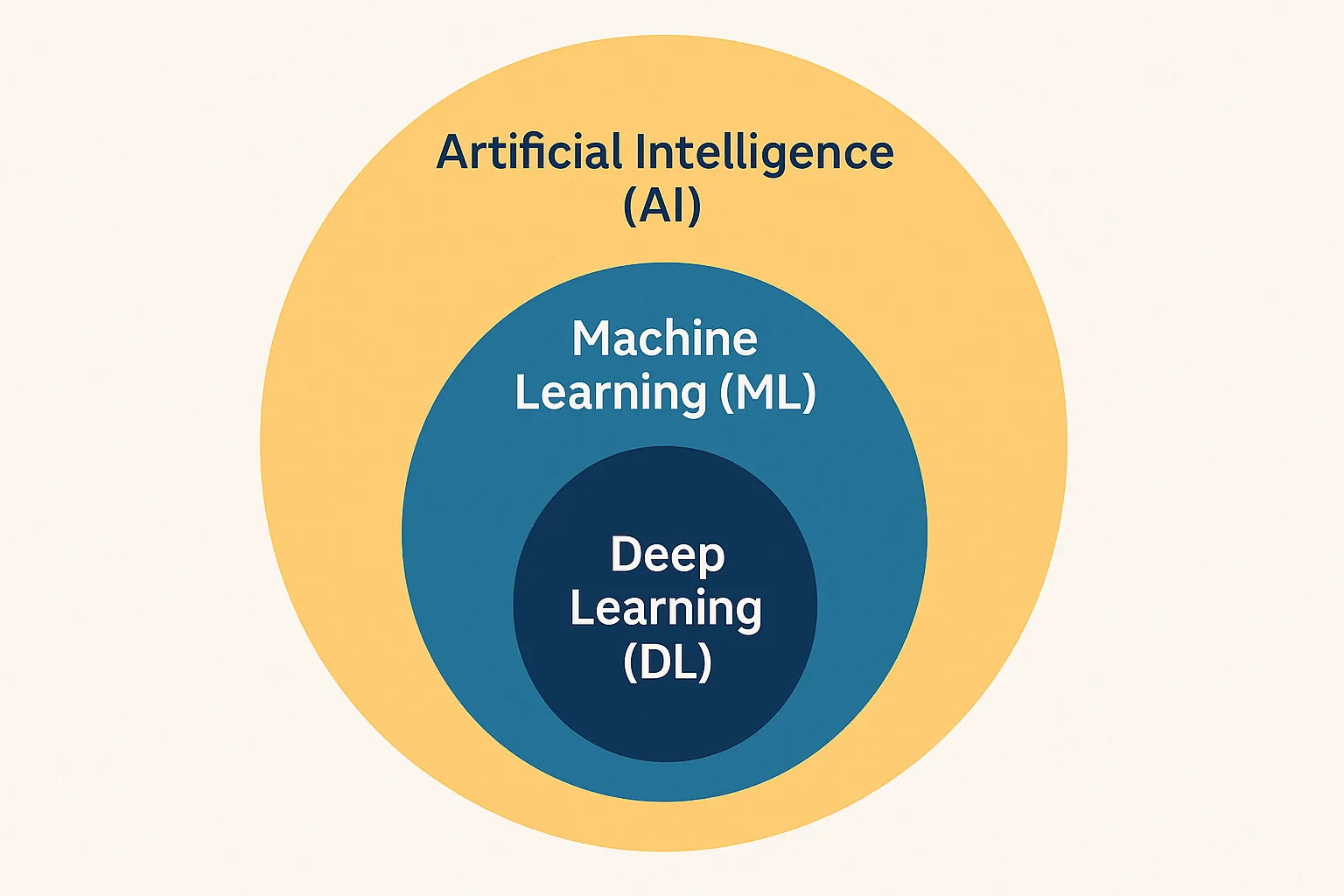
Artificial intelligence, machine learning, and deep learning are part of the same family, but they sit at different levels of the stack. AI is the big umbrella: any technique that lets computers perform tasks we’d normally call “intelligent,” from planning and reasoning to understanding language. Machine learning is a way of building AI systems that improve through experience with data rather than hard-coded rules. Deep learning is a particular style of machine learning that uses layered neural networks to learn rich representations directly from raw data like images, audio, and text.
Understanding Artificial Intelligence (AI)
Think of AI as the goal: systems that perceive, reason, and act. Sometimes the approach is rule-based—expert systems, search and planning, symbolic logic. Other times it’s data-driven—learning patterns from examples. Customer service bots, route optimisers, recommendation systems and decision support dashboards all live comfortably under the AI umbrella. The key point is breadth: AI is the field concerned with making machines useful at cognitive tasks, no matter which method we use to get there.
What Machine Learning Adds
Machine learning narrows the focus to algorithms that learn from data. Instead of telling the computer what to do step by step, we show it examples and let it infer the mapping from inputs to outputs. A credit-risk model trains on past applications; a spam filter learns from labelled emails; anomaly detection finds unusual behaviour without labels at all. Good ML work balances three ingredients: appropriate algorithms, high-quality data, and thoughtful evaluation. Feature engineering—how we represent the data—often makes or breaks performance, especially when inputs are tabular or structured.
Where Deep Learning Fits In
Deep learning is machine learning with many-layered neural networks. Those layers act as stages of representation: early layers capture simple patterns, later layers assemble them into concepts. The result is an approach that thrives on unstructured data. Convolutional networks learn directly from pixels; transformers model sequences of words and even audio; vision-language models combine modalities. Deep learning tends to scale well with data and compute, but it also demands both—plus careful training, regularisation and validation to avoid overfitting or spurious correlations.
Key Differences at a Glance
| Scope | Artificial Intelligence (AI) | Machine Learning (ML) | Deep Learning (DL) |
|---|---|---|---|
| What it is | Goal of building intelligent behaviour by any method | Data-driven techniques that learn patterns from examples | ML using multilayer neural networks for representation learning |
| Data/Features | May be rule-based or learned | Often relies on feature engineering | Learns features automatically from raw data |
| Strengths | Flexible toolkit for many problems | Strong on structured/tabular data and clear targets | State-of-the-art on text, images, audio and multi-modal tasks |
| Costs | Varies by method | Moderate data and compute needs | High data and compute; careful training required |
Choosing the Right Approach
If your inputs are clean rows and columns and the target is well defined, classical ML methods (gradient boosting, linear models, random forests) are reliable, transparent, and fast to iterate. If your inputs are pixels, waveforms, free-form text, or a mix of modalities, deep learning usually wins because it learns the representation for you. Many real systems blend both: a deep model turns raw content into embeddings, then a downstream ML model or simple rules make the final decision within a product workflow.
Everyday Examples
Search engines rank results with a cascade of ML and DL models. Banks score risk and detect fraud with tabular ML plus behavioural embeddings. In healthcare, deep models read imaging and language models help clinicians summarise notes, while traditional ML forecasts readmission risk from structured records. Even your streaming app blends collaborative filtering with deep representation learning to recommend what you’ll enjoy next.
FAQs
- Is deep learning “better” than machine learning? Neither is universally better. Deep learning excels on unstructured data at scale; many business problems with structured data are solved faster and more transparently with classic ML.
- Can AI exist without ML? Yes. Planning algorithms, constraint solvers and expert systems are AI without learning from data.
- Do all ML models use neural networks? No. Decision trees, gradient boosting, support-vector machines and linear models are common non-neural techniques.
- Why does deep learning need so much data? Large networks have many parameters. Abundant data (and regularisation) prevents overfitting and lets the model learn robust representations.
- When should I choose DL over ML? Prefer DL for images, audio, natural language, and multi-modal inputs—or when representation learning clearly outperforms hand-crafted features.
Related Posts
- Exploring Transfer Learning in AI: How to Use Pre-trained Models for Your Projects
- Data Augmentation Techniques to Improve AI Model Generalization
- Natural Language Processing: A Beginner’s Guide
- How to Build a Neural Network from Scratch in Python
- Three Increasingly Complex Ways to Model and Forecast Time Series Data



